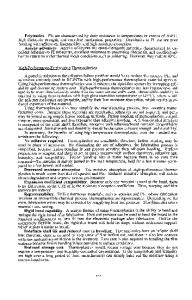Embedding Ceramic Thick-Film Capacitors into Printed Wiring Boards
- PDF / 2,183,506 Bytes
- 9 Pages / 612 x 792 pts (letter) Page_size
- 89 Downloads / 320 Views
G4.1.1
Embedding Ceramic Thick-Film Capacitors into Printed Wiring Boards William Borland, Marc Doyle, Lynne Dellis, Olga Renovales, and Diptarka Majumdar DuPont Electronic Technologies, Research Triangle Park, NC 27709 ABSTRACT Embedding passives into printed wiring boards have numerous advantages that show up in different segments of the market. For example, the ability to locate decoupling capacitors within a couple hundred microns of semiconductor I/Os greatly improves response time and signal integrity leading to product performance improvements. One crucial need, however, is high capacitance density. High capacitance density can only be readily achieved by ceramic technology. Therefore, the focus of this work has been the development of ceramic thick-film capacitor technology that can be used to bury high capacitance density components within an organic substrate. This allows high value decoupling capacitors to be buried for chip packaging or related applications in spaces available within any layer of the substrate. The dielectric paste is based on doped barium titanate composition and works together with a cofired copper electrode paste. The capacitor system is designed to be screen printed on copper foil in the locations desired in the circuit and fired in nitrogen at 900°C to form the ceramic components. Following this, the foil is laminated, component face down, to the organic laminate using standard prepreg and the inner layer etched to reveal the components in an organic matrix. The system has a dielectric constant of approximately 3000 and achieves a capacitance density of ~1.5 nF/mm2. In the following sections, issues that we encountered when making embedded capacitors with this first generation system are presented. INTRODUCTION Current commercially available embedded passive materials include etchable thin film resistor laminates, organic capacitor laminates, and polymer thick-film capacitors and resistors. The capabilities and limitations with existing systems have been discussed in the literature.1-5 The current work began as part of the Advanced Embedded Passives Technology (AEPT) consortium and was co-funded by the National Institute of Standards and Technology of the U.S. Government and industry participants6. Objectives included the development of a process and materials system that would allow ceramic components with high capacitance density to be buried inside PCBs. A ceramic thick-film process was chosen for embedding ceramic capacitors. The process is based on a combination of two well-understood commercial processes: nitrogen-fired thick-film hybrid production and traditional printed circuit board fabrication.7 The process flow for embedding ceramic passives has been documented elsewhere.7-10 In brief, it uses a thick film paste based on barium titanate and glass to form fired ceramic capacitors on copper foil followed by standard PWB processes to embed the capacitors into the PWB. Figure 1 illustrates the process flow. FIRING CAPACITORS ON COPPER FOIL When a copper foil with screen-prin
Data Loading...











